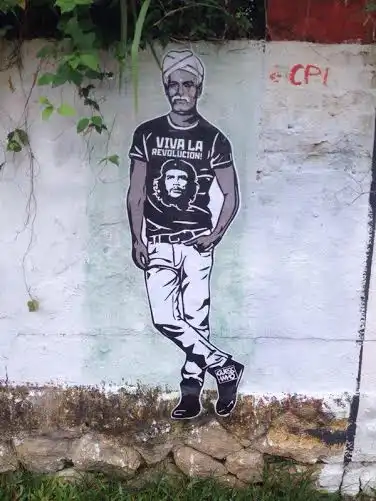Street art Guess Who Kochi India Bob Marley Che Guevara
An anonymous artist named 'Guess Who' merges Western and Indian icons on Fort Kochi's walls as a protest against Kochi Biennale.
The streets of Fort Kochi are filled once again with the lingering scent of paint, primer, history, and a faint, elusive beauty. The installations and makeshift studios of the Biennale have started cropping up, but on the once-abandoned pale, mossy walls, an art of a different kind has sprung up. The anonymous graffiti artist, known simply as 'Guess Who,' has merged Western/global and Indian/local icons on the street walls of Fort Kochi, a region of Kochi, a port city in the state of Kerala in southern India. His work includes iconic images of Bob Marley and Che Guevara, which are a protest against the selection criteria of the 2 Kochi Biennale, which opened on December 12. The artwork is Guess Who's protest against the selection criteria of the 2 Kochi Biennale, which opened on December 12. Rochelle Dsouza writes for the Times of India that Guess Who's work reminds us what real art should be: Demotic, cross-cultural, transient, artisanal, unpretentious and, not least, eponymous.
The installations and makeshift studios of the Biennale have started cropping up, but on the once abandoned pale, mossy walls an art of a different kind has sprung up. The anonymous artist(s) has painted the streets and the minds of his audience with curiosity, a sense of excitement, and a little tickle to the funny bone. Who is this entity? No one knows. Known simply as the 'Guess Who Artists', the anonymity is a conscious decision, a part of the MO. Whether 'Guess Who' is a single artist or a group or just a school of thought is a mystery, a guessing game. "The focus should be on art not the artist. There's charm in being anonymous, it is a position that the artist seldom takes to make art and give it to the public, stand away and watch them enjoy it. Being anonymous also helps you, the audience, be free of any prejudices about the identity of the artist (gender, religion, caste, age etc.) It would also help you to handle more sensitive and political subjects," Guess Who deigns to tell me over a Gmail chat after much persuasion and hand wringing.
Guess Who's intention is to take art mainly to those who are not otherwise interested in it and start a dialogue. "Street art is the best way to do that. The viewer is forced to engage with it, knowingly or unknowingly. We have a lot of good artists but we don't have an art culture here. We don't teach our kids about art in our schools. We don't have a Tate Modern or MOMA or Center Pompidou. There now have been efforts like the Biennale. But it will take time. The best way to reach out is to drag them into it. And street art is the way." When asked about the nature of the artwork, the blend of eastern and western popular culture and imagery, here's the reply: "It is easy for a visual connection if you use popular imagery. If it is not intended for an art enthusiast but a common man, it has to be easily identifiable. People in Fort Kochi may not connect immediately with the imagery of the Blue Man by Matisse but would with an image of Sakuntala."
Guess Who uses wheat paste posters as a medium for art. "It's faster to implement. Not as laborious as stencil cutting. Cheaper than spray paint. But does technique matter? And yes, it may not stay forever. It is not supposed to."
Contrary to popular belief, Guess Who is not a part of the Kochi Biennale, never has been. Why? Well, because Guess Who believes that its works are not worth being a part of the Biennale. The work addresses a different audience. Guess Who is "only meant for a lighter viewing experience, not to be taken very seriously." It has nothing against the so-called mainstream or established art but, "As the word 'established' suggests, it is mainly for established art and artists and one needs a bit of background knowledge and training in art history, art movements and the like to enjoy mainstream art. Unfortunately our current education system is not designed that way. Graffiti on the other hand gives you more freedom. There's no curator to limit your freedom. The funniest thing is that graffiti has now become mainstream in the West. But we have a long way to go."












Comments on Street art Guess Who Kochi India Bob Marley Che Guevara